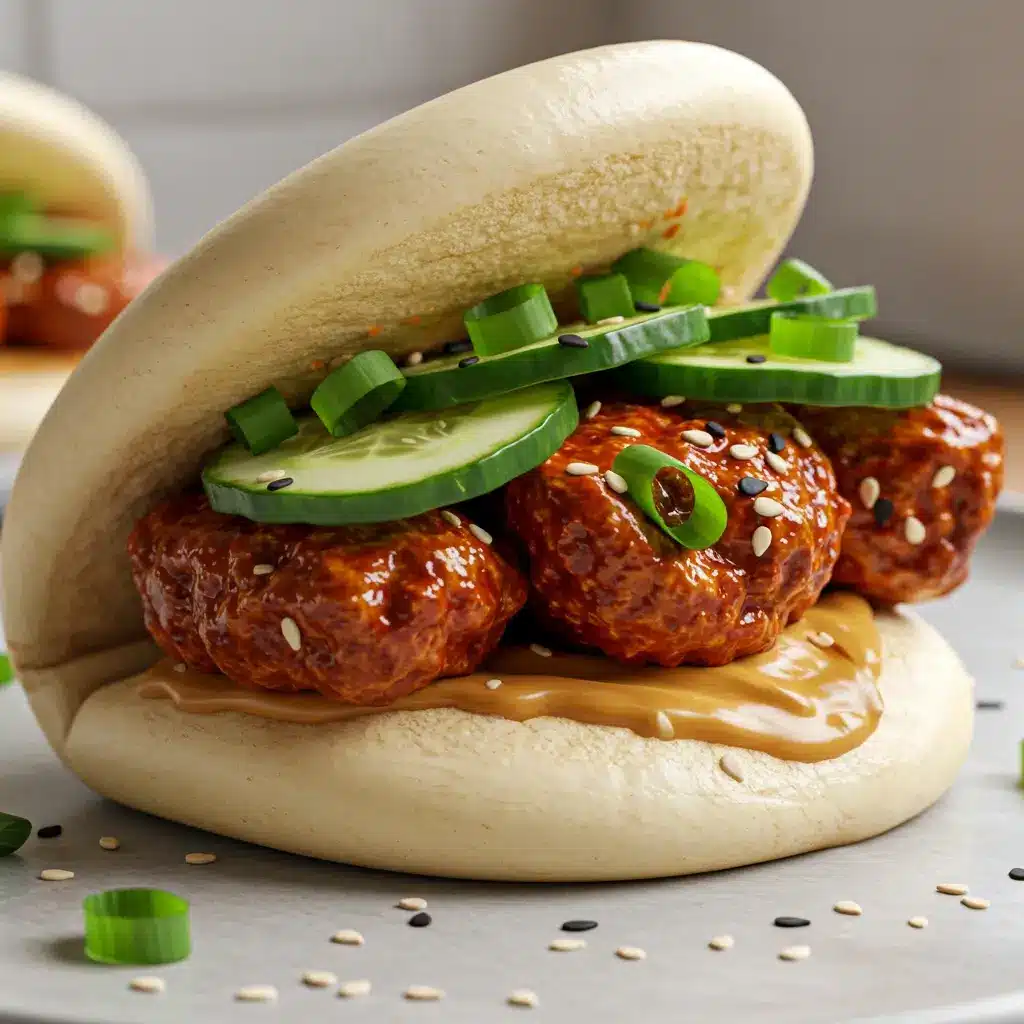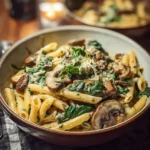Korean cuisine is renowned for its bold flavors and unique culinary experiences. One such delightful creation is the Korean Chicken Bao. This dish combines tender, spicy chicken with the soft, pillowy texture of bao buns, offering a fusion of flavors that is sure to tantalize your taste buds. Whether you’re a fan of Korean food or looking to try something new, this dish is perfect for an exciting culinary adventure. In this article, we’ll explore the ingredients, step-by-step instructions, nutritional information, serving suggestions, and some additional tips to make your Korean Chicken Bao experience unforgettable.
Ingredients
Before we get into the nitty-gritty of preparation, let’s gather all the ingredients you’ll need to craft these delicious Korean Chicken Baos:
- 1 lb boneless chicken thighs, diced
- 1 tbsp soy sauce
- 1 tbsp gochujang (Korean chili paste)
- 1 tsp honey
- 1 garlic clove, minced
- 1 tbsp sesame oil
- 4 bao buns (store-bought)
- Cucumber slices
- Sliced green onions
- Sesame seeds
Having these ingredients ready will make the cooking process smooth and enjoyable.
Instructions
Creating your own Korean Chicken Bao is straightforward and can be accomplished in a few simple steps. Follow this guide to bring this delicious dish to life:
- Prepare the Marinade:
- In a bowl, mix together the soy sauce, gochujang, honey, minced garlic, and sesame oil until well combined.
- Marinate the Chicken:
- Add the diced chicken thighs to the marinade, ensuring each piece is well coated.
- Allow the chicken to marinate for at least 15 minutes to absorb the flavors.
- Cook the Chicken:
- Heat a skillet over medium heat.
- Add the marinated chicken to the skillet and cook for 8-10 minutes, stirring occasionally, until the chicken is fully cooked and slightly caramelized.
- Steam the Bao Buns:
- While the chicken is cooking, steam the bao buns according to the package instructions. This usually takes about 5-7 minutes.
- Assemble the Bao:
- Once the chicken is cooked and the bao buns are steamed, it’s time to assemble your Korean Chicken Bao.
- Place a generous amount of chicken inside each bao bun.
- Top with cucumber slices, sliced green onions, and a sprinkle of sesame seeds for added texture and flavor.
- Enjoy:
- Serve your Korean Chicken Bao immediately while the buns are soft and warm. Enjoy the explosion of flavors with every bite!
Nutrition Facts
Understanding the nutritional content of your meal can help you make informed dietary choices. Here’s a breakdown of the nutrition facts per serving for Korean Chicken Bao:
- Calories: 300
- Protein: 25g
- Carbs: 30g
- Fat: 10g
These figures make Korean Chicken Bao a balanced meal with a good mix of protein, carbohydrates, and fats.
How to Serve
Serving Korean Chicken Bao is not just about the taste; it’s also about the experience. With a few thoughtful touches, you can transform a simple meal into a delightful culinary event that excites the senses and encourages social interaction. Here are some creative ideas to elevate your dining experience:
Platter Presentation
Garnished Arrangement: Start by arranging the assembled baos on a large, visually appealing platter. Consider using a wooden or bamboo board for a rustic touch that complements the Asian theme. Place the baos in a circular or staggered formation to create visual interest.
Colorful Garnishes: Enhance the visual appeal by garnishing the platter with vibrant extras. Slice fresh cucumbers into thin rounds or ribbons and scatter them around the baos to add a pop of color and a refreshing crunch. Chopped green onions can be sprinkled on top of the baos for a touch of green and a burst of flavor. For a finishing touch, sprinkle toasted sesame seeds over the entire platter, which not only adds texture but also an inviting nutty aroma.
Herb Accents: Consider adding fresh herbs, such as cilantro or Thai basil, around the platter to enhance the presentation and introduce additional layers of flavor. These herbs can also be used as a garnish on individual baos, allowing guests to customize their bites.
Side Dishes
Kimchi: No Korean meal is complete without kimchi. The spicy, fermented vegetables will provide a tangy contrast to the soft, pillowy baos. Offer a variety of kimchi options—such as classic napa cabbage kimchi or a spicier radish kimchi—to cater to different taste preferences. Present the kimchi in small, colorful bowls to create an inviting spread.
Asian-style Salad: A fresh salad can balance the richness of the bao. Consider a light Asian-style salad with thinly sliced cabbage, carrots, and bell peppers, dressed in a sesame vinaigrette. Adding elements like mandarin oranges or crispy wonton strips can introduce sweetness and crunch, making the salad a delightful complement to the baos.
Pickles and Ferments: Incorporating a selection of pickled vegetables can add an extra layer of flavor and texture. Try serving pickled daikon or pickled radishes, which can enhance the overall meal by providing a refreshing acidity that cuts through the richness of the chicken bao.
Dipping Sauce
Gochujang Sauce: For those who enjoy a kick of heat, serve additional gochujang on the side. This fermented chili paste adds a rich, umami flavor that can be adjusted to individual spice levels. Consider mixing it with a bit of honey or sesame oil to create a balanced dipping sauce that combines sweetness with heat.
Soy Sauce-based Dipping Sauce: A soy sauce-based dipping sauce can appeal to those who prefer a more savory option. Combine soy sauce with rice vinegar, a touch of sesame oil, and finely chopped garlic or ginger to create a flavorful dip. Adding a sprinkle of chopped scallions or a few drops of chili oil can give it an extra layer of flavor and heat.
Create a Dipping Station: To make the dining experience more interactive, set up a small dipping station where guests can customize their sauces. Provide small bowls for each sauce and offer a variety of toppings, such as chopped chili, crushed peanuts, or even a dash of lime juice, allowing guests to mix and match according to their tastes.
Final Touches
Drink Pairings: Don’t forget about beverage pairings! Serve traditional Korean drinks like soju or makgeolli for a cultural touch. Alternatively, a light beer or a refreshing iced tea can complement the meal well.
Dining Environment: Consider the dining atmosphere as well. Play soft Korean music in the background to enhance the cultural experience and create a relaxed ambiance. Dim lighting or decorative candles can add to the inviting atmosphere, making your meal feel special and memorable.
By incorporating these presentation and serving ideas, you can create a dining experience that is not only delicious but also visually stunning and culturally immersive. Your guests will appreciate the attention to detail, and the meal will become a cherished memory.
Additional Tips for Perfecting Your Korean Chicken Bao
To ensure your Korean Chicken Bao is a culinary success, consider these additional tips that will enhance both the flavor and presentation of your dish:
Marination Time
The marination process is crucial for infusing the chicken with flavor. While marinating for 30 minutes will impart a decent taste, allowing the chicken to marinate for up to 2 hours—or even overnight—can significantly enhance the overall flavor profile. The longer marination time enables the ingredients, especially soy sauce, garlic, and ginger, to penetrate deeper into the meat, resulting in a more flavorful and tender chicken. If you’re pressed for time, consider using a vacuum-seal bag to speed up the marination process; this helps the chicken absorb flavors more quickly.
Gochujang Levels
Gochujang, a staple in Korean cuisine, imparts not just heat but also a unique sweetness and umami to the dish. When preparing your marinade, be mindful of your preferred spice level. Start with a smaller amount—perhaps 1 tablespoon—and taste as you go. This allows you to tailor the heat to your liking. If you’re serving guests, consider providing additional gochujang on the side, allowing them to customize their bao to their own heat preferences. Alternatively, for those who might be sensitive to spice, pairing gochujang with a sweetener like honey or maple syrup can help balance the heat while maintaining a delicious flavor.
Bao Bun Variations
While traditional bao buns are soft and pillowy, there are numerous variations that can add a unique twist to your Korean Chicken Bao. Experimenting with different bao bun flavors can elevate your dish. Whole wheat bao buns not only offer a nutty flavor but also provide added fiber, making your meal healthier. Black sesame bao buns, on the other hand, provide a striking visual contrast and a subtle nutty flavor that complements the richness of the chicken filling. You can also make or purchase bao buns infused with herbs, such as spinach or beetroot, which can add a vibrant color and additional nutrients to your meal.
Vegetarian Option
For those seeking a vegetarian or plant-based alternative, substituting chicken with tofu or tempeh is an excellent option. Firm tofu, when marinated and grilled or sautéed, can mimic the texture of chicken while absorbing the flavors of the marinade beautifully. To prepare, press the tofu to remove excess moisture, then cut it into bite-sized cubes and marinate just as you would the chicken. Tempeh, with its nutty flavor and firmer texture, also works well in this dish. Slice the tempeh into thin strips, steam it briefly to soften, then marinate and cook it in a similar manner. You can also enhance these vegetarian options by incorporating vibrant vegetables such as bell peppers, carrots, or mushrooms into the filling, adding both color and nutrition to your bao.
Additional Flavor Enhancements
To further elevate your Korean Chicken Bao, consider incorporating additional toppings and garnishes. Fresh herbs like cilantro or green onions can provide freshness and a pop of color. Pickled vegetables, such as daikon or kimchi, can add acidity and crunch, balancing the richness of the chicken. A drizzle of sesame oil or a sprinkle of toasted sesame seeds can also enhance the flavor profile, adding a nutty aroma and a delightful crunch.
Serving Suggestions
Presentation plays a key role in enjoying your meal. Serve your Korean Chicken Bao on a vibrant platter, perhaps garnished with sesame seeds and fresh herbs. Accompany the bao with a side of pickled vegetables or a light salad to balance the meal. If you’re hosting a gathering, consider setting up a bao assembly station, allowing guests to customize their creations with various toppings and sauces. This interactive element not only enhances the dining experience but also encourages creativity in flavor combinations.
By keeping these tips in mind, you can elevate your Korean Chicken Bao from a simple dish to an unforgettable culinary experience that delights the senses. Enjoy the process of cooking and tasting, and don’t hesitate to experiment with flavors and textures to create your perfect bao!
FAQs
1. Can I use chicken breast instead of thighs?
Yes, you can use chicken breast instead of thighs. However, chicken thighs tend to be juicier and more flavorful, which complements the bao well.
2. Where can I find gochujang?
Gochujang is commonly available in Asian grocery stores or the international aisle of well-stocked supermarkets. It can also be purchased online.
3. Can I make my own bao buns?
Absolutely! Making bao buns from scratch can be a fun culinary project. There are many recipes available online if you wish to try making them at home.
4. How can I store leftovers?
If you have any leftovers, store the chicken and bao buns separately in airtight containers. Reheat the chicken in a skillet or microwave and steam the buns again before serving.
Conclusion
The Korean Chicken Bao is a delightful fusion dish that brings together the best of both worlds—Korean flavors and the unique texture of bao buns. With its savory, spicy chicken filling and fresh toppings, this dish is perfect for any occasion, from casual family dinners to impressing guests at a dinner party. By following the steps outlined in this article, you can easily create your own Korean Chicken Bao and embark on a culinary journey that celebrates bold flavors and delicious textures. So, gather your ingredients, follow the instructions, and enjoy the delightful taste of Korean Chicken Bao!
Print
Korean Chicken Bao Recipe
Ingredients
- 1 lb boneless chicken thighs, diced
- 1 tbsp soy sauce
- 1 tbsp gochujang (Korean chili paste)
- 1 tsp honey
- 1 garlic clove, minced
- 1 tbsp sesame oil
- 4 bao buns (store-bought)
- Cucumber slices
- Sliced green onions
- Sesame seeds
Instructions
- Prepare the Marinade:
- In a bowl, mix together the soy sauce, gochujang, honey, minced garlic, and sesame oil until well combined.
- Marinate the Chicken:
- Add the diced chicken thighs to the marinade, ensuring each piece is well coated.
- Allow the chicken to marinate for at least 15 minutes to absorb the flavors.
- Cook the Chicken:
- Heat a skillet over medium heat.
- Add the marinated chicken to the skillet and cook for 8-10 minutes, stirring occasionally, until the chicken is fully cooked and slightly caramelized.
- Steam the Bao Buns:
- While the chicken is cooking, steam the bao buns according to the package instructions. This usually takes about 5-7 minutes.
- Assemble the Bao:
- Once the chicken is cooked and the bao buns are steamed, it’s time to assemble your Korean Chicken Bao.
- Place a generous amount of chicken inside each bao bun.
- Top with cucumber slices, sliced green onions, and a sprinkle of sesame seeds for added texture and flavor.
- Enjoy:
- Serve your Korean Chicken Bao immediately while the buns are soft and warm. Enjoy the explosion of flavors with every bite!
Nutrition
- Serving Size: One Normal Portion
- Calories: 300
- Fat: 10g
- Carbohydrates: 30g
- Protein: 25g





